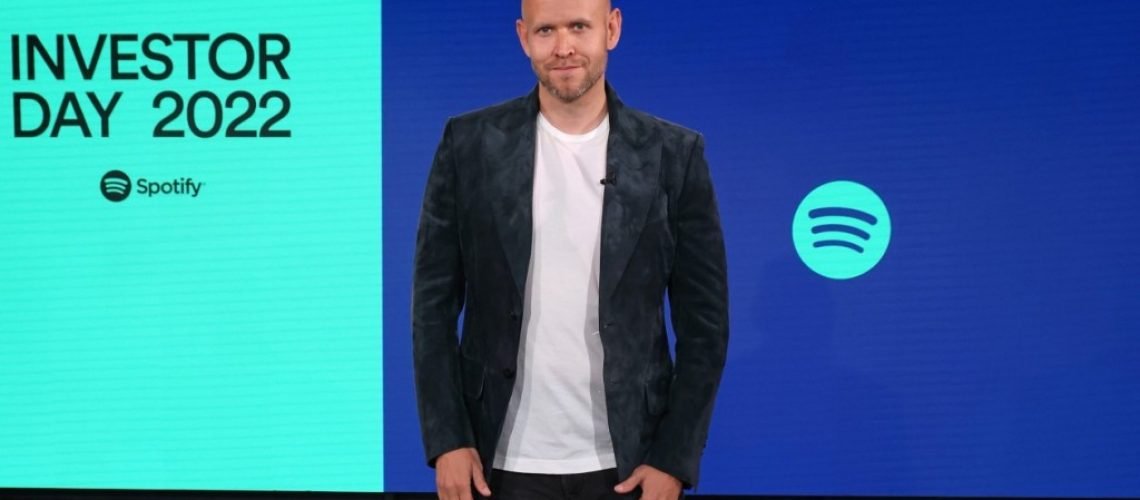Spotify CEO Daniel Ek and a parade of top executives had a simple message for investors in a live-streamed presentation from New York on Wednesday (June 8): Our margins will be better.
Although the company has communicated its long-term vision through quarterly earnings calls, press releases and occasional Wall Street conferences, it hasn’t gathered the investment community for a meaningful conversation since going public in 2018. “I’m not sure that journey’s very well understood,” said Ek. “And, frankly, we probably haven’t done a very good job explaining it.” Despite posting 24% revenue growth in both 2021 and the first quarter of 2022, the company’s share price is down 51.7% in 2022.
As CEO, Ek’s job on Wednesday was to captain the nearly four-hour presentation communicating to investors just how exactly Spotify has been misunderstood. More importantly, Ek laid out how they intend to reach the lofty goals of $100 billion in annual income with 40% gross margin and 20% operating margin. All three measures would be a significant leap from its 2021 financial performance of $10.9 billion revenue with 28% gross margin and 1% operating margin.
To achieve this, rather than music Spotify executives focused on non-music content such as podcasts, and audiobooks to a lesser degree. The company still sees itself primarily as a music service and music is the cornerstone to its platform, but — as it detailed throughout the presentation — the larger opportunity is being an audio company that provides both music and non-music content in a single product.
Currently, however, podcasts are a financial drain on the company. While music has a 28% gross margin, podcasting’s gross margin is -57%. Although podcasting grew more than 300% to nearly $200 million in 2021, that came with a $103-million negative impact on gross profit, said CFO Paul Vogel. That’s because Spotify must buy and build the tools, products and exclusive and original content in order to capitalize on podcast’s potential. To date, Spotify has acquired content creators such as Gimlet and The Ringer, as well as tech platforms like Megaphone and Anchor. It licenses exclusive podcasts such as The Joe Rogan Experience and Call Her Daddy and has partnered with the likes of former first couple Barack and Michelle Obama and DC Comics for original programming.
The investments could pay off if podcasting can pull up the company’s average gross margin. Spotify believes it can achieve podcast gross margins of 30-35% within three to five years and sees 40-50% as attainable further in the future. The trick will be getting the necessary scale. Anchor, a platform for do-it-yourself podcast creators, powers more than 75% of Spotify’s more than 4 million podcasts, which has grown from fewer than 500,000 since it acquired Anchor in 2019, said Maya Prohovnik, head of talk. Megaphone, a podcast distribution and monetization tool, helps attract more podcast creators, which gives them the advertising inventory it needs to generate significant podcast revenues. As a result, the percentage of Spotify users that listen to podcasts rose from 7–30% from 2018–2021.
In fact, it’s hard to imagine Spotify getting to its goal of 1 billion users by 2030 on music alone. As numerous executives explained, podcasts keep users engaged longer, reduce churn and attract larger advertiser spends. The result is greater lifetime value, an increasingly important internal metric that helps Spotify determine the effectiveness of its content recommendations, advertising placements and new product features. Podcasts, which Dawn Ostroff, chief content and advertising business officer, called a $20 billion opportunity, will also be crucial to reaching $100 billion in annual revenue.
Music will play a less crucial role than many people might expect – for a couple reasons. First, Spotify doesn’t have much wiggle room in music licensing costs because terms are standardized. Spotify’s licensing agreements with record labels give the rights owners a share of subscription and advertising revenue. Second, Spotify’s music costs are mostly variable, not fixed, meaning the more music revenue it generates, the more it pays to rights holders. Without a ceiling on music licensing costs, Spotify looked elsewhere for margin relief.
“Our strategy is not predicated on trying to extract margin by negotiating better terms with the content partners we have,” said Ek. Rather, Spotify wants to turn labels into customers by helping them market their releases on the platform — similar to how record stores sell shelf space to labels. The more services the labels buy from Spotify, the more Spotify does to help labels monetize casual fans, the better Spotify’s gross margin. Spotify calls this its two-sided marketplace, a way to generate revenue from the rights holders that licensing music necessary to the business model. There’s enormous potential, said Ek. “We’re still a very, very small portion of all labels’ marketing spend.”
Spotify wants to improve its music gross margins from 28% in 2021 to 30% in the next three to five years. (Gross margin is revenues minus cost of revenue excluding expenses such as salaries, marketing and sales). Over the long term, Spotify wants to achieve a 35% gross margin for music revenue.
Beyond podcasts, exactly how Spotify could reach $100 billion in annual revenues is less clear. Audiobooks is the next product category on the road map. The company started by acquiring audiobook producer and distributor Findaway in Nov. 2021, and Nir Zicherman, global head of audiobooks, said Spotify will bring more innovation to the space than the lone major player, Amazon-owned Audible. Audiobooks have a 6-7% share of the $140 billion global book market but can reach a 50% share in mature markets, according to Ek. From there, executives teased two other potentially lucrative categories for its expansion plans: news and education.
Spotify’s share price rose as much as 8.7% to $109.43 on Wednesday and closed up 6% at $116.03.




